PONTIAC GRAND AM 1998 Owners Manual
Manufacturer: PONTIAC, Model Year: 1998, Model line: GRAND AM, Model: PONTIAC GRAND AM 1998Pages: 370, PDF Size: 16.11 MB
Page 111 of 370
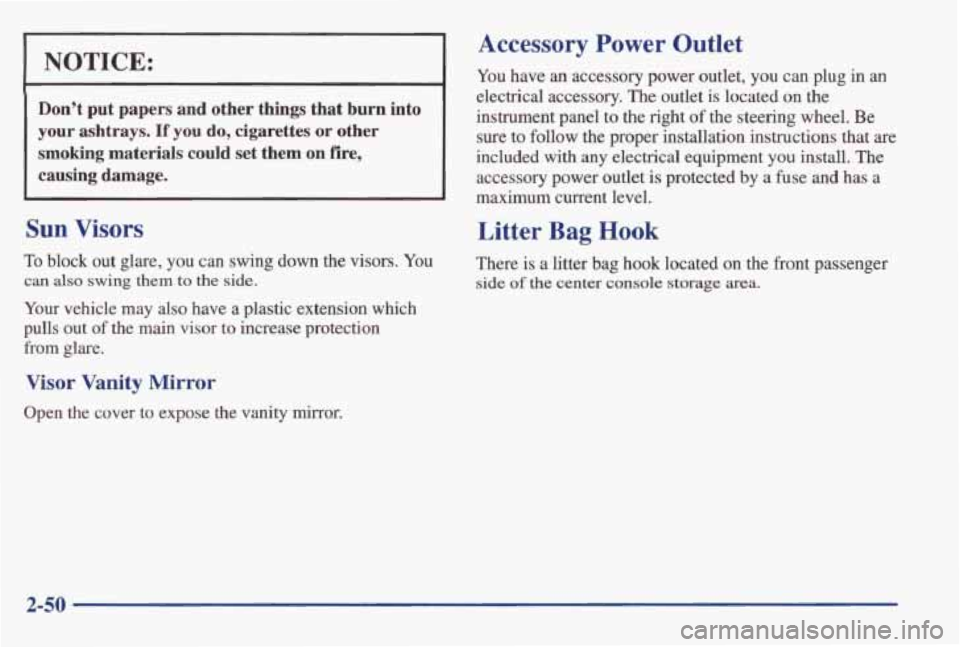
NOTICE:
Accessory Power Outlet
You have an accessory power outlet, you can plug in an
electrical accessory. The outlet is located on the
instrument panel to the right
of the steering wheel. Be Don’t put papers and other things that burn into
your ashtrays.
If you do, cigarettes or other
accessory power outlet is protected by a fuse and has a causing damage.
included with any electrical equipment you install. The smoking materials could set them on fire,
sure to follow the proper installation instructions that are
maximum current level.
Sun Visors
To block out glare, you can swing down the visors. You
can also swing them to the side.
Your vehicle may also have a plastic extension which
pulls out of the main visor to increase protection
from glare.
Visor Vanity Mirror
Open the cover to expose the vanity mirror.
Litter Bag Hook
There is a litter bag hook located on the front passenger
side of the center console storage area.
2-50
Page 112 of 370
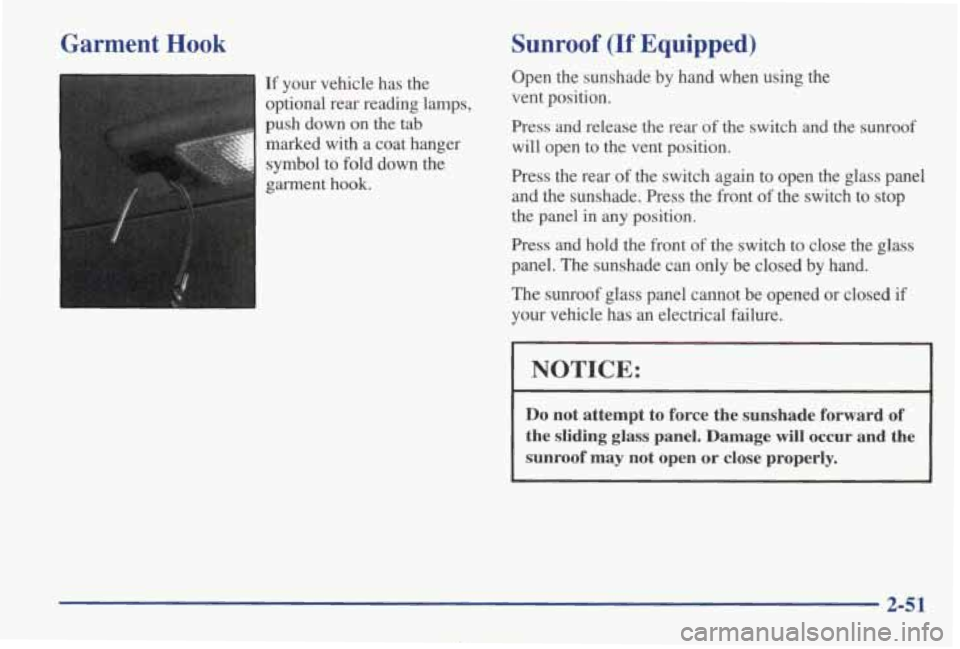
Garment Hook
If your vehicle has the
optional rear reading lamps,
push down
on the tab
marked with a coat hanger symbol to fold down the
garment hook.
Sunroof (If Equipped)
Open the sunshade by hand when using the
vent position.
Press and release the rear
of the switch and the sunroof
will open to the vent position.
Press the rear of the switch again to open the glass panel
and the sunshade. Press the front
of the switch to stop
the panel in any position.
Press and hold the front of the switch to close the glass
panel. The sunshade can only be closed by hand.
The sunroof glass panel cannot be opened or closed if
your vehicle has 'an electrical failure.
KNOTICE:
Do not attempt to force the sunshade forward of
the sliding glass panel. Damage
will occur and the
sunroof may not open or close properly.
2-51
Page 113 of 370
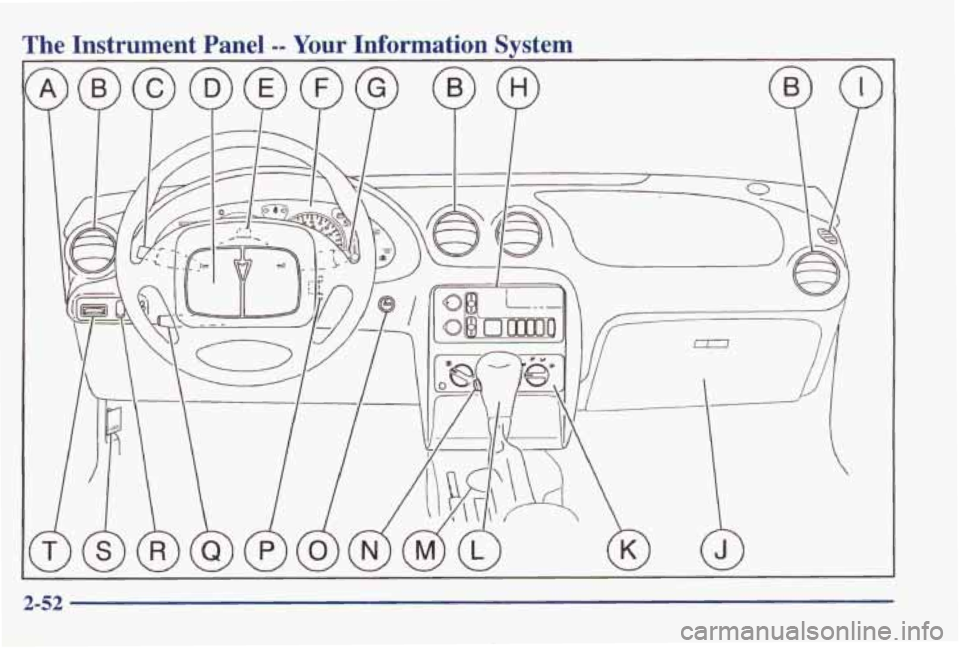
The Instrument Panel -- Your Information Svstem
Page 114 of 370
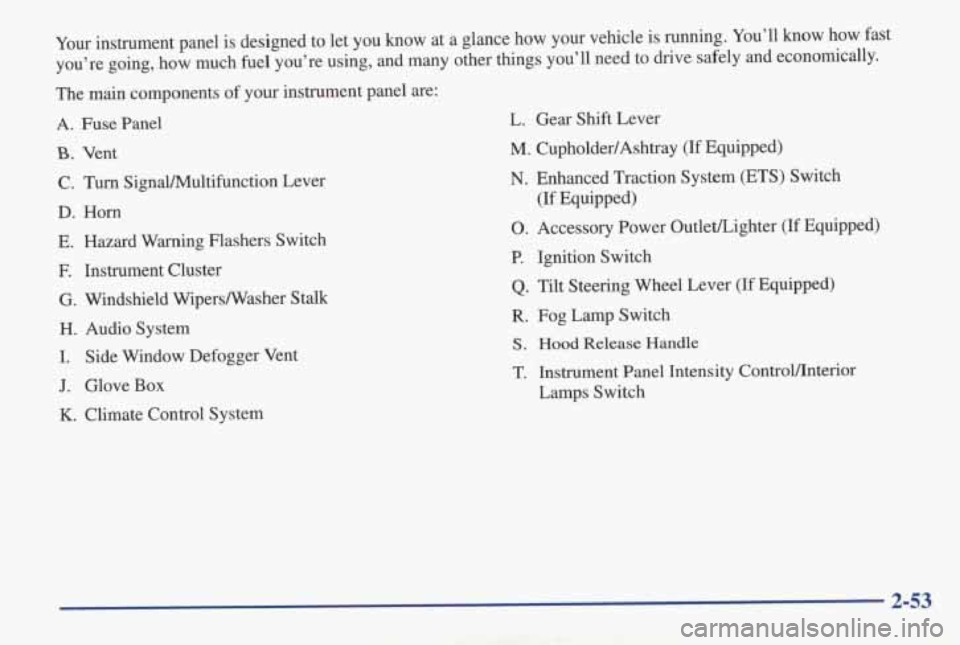
Your instrument panel is designed to let you know at a glance how \
your vehicle is running. You’ll know how fast
you’re going, how much
fuel you’re using, and many other things you’ll need to drive \
safely and economically.
The main components of your instrument panel are:
A. Fuse Panel
B. Vent
C. Turn SignaVMultifunction Lever
D. Horn
E. Hazard Warning Flashers Switch F. Instrument Cluster
G. Windshield WipersNasher Stalk
H. Audio System
I. Side Window Defogger Vent
J. Glove Box
K. Climate Control System L. Gear Shift Lever
M. CupholdedAshtray (If Equipped)
N. Enhanced Traction System (ETS) Switch
0. Accessory Power
Outlenighter (If Equipped)
(If Equipped)
P. Ignition Switch
Q. Tilt Steering Wheel Lever (If Equipped)
R. Fog Lamp Switch
S. Hood
Release Handle
T. Instrument Panel Intensity ControlDnterior
Lamps Switch
2-53
Page 115 of 370
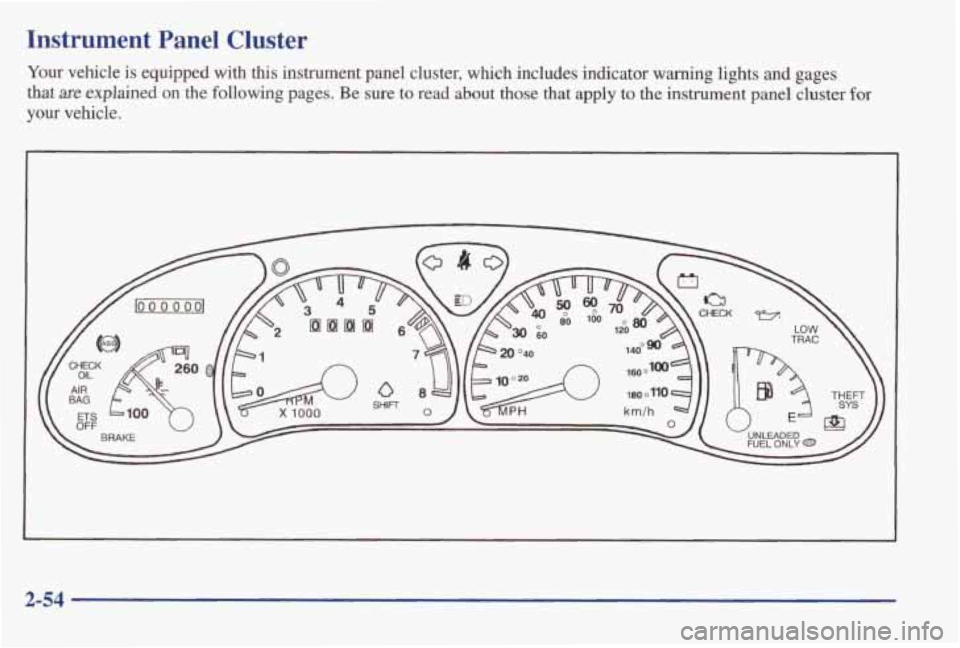
Instrument Panel Cluster
2-54
Page 116 of 370
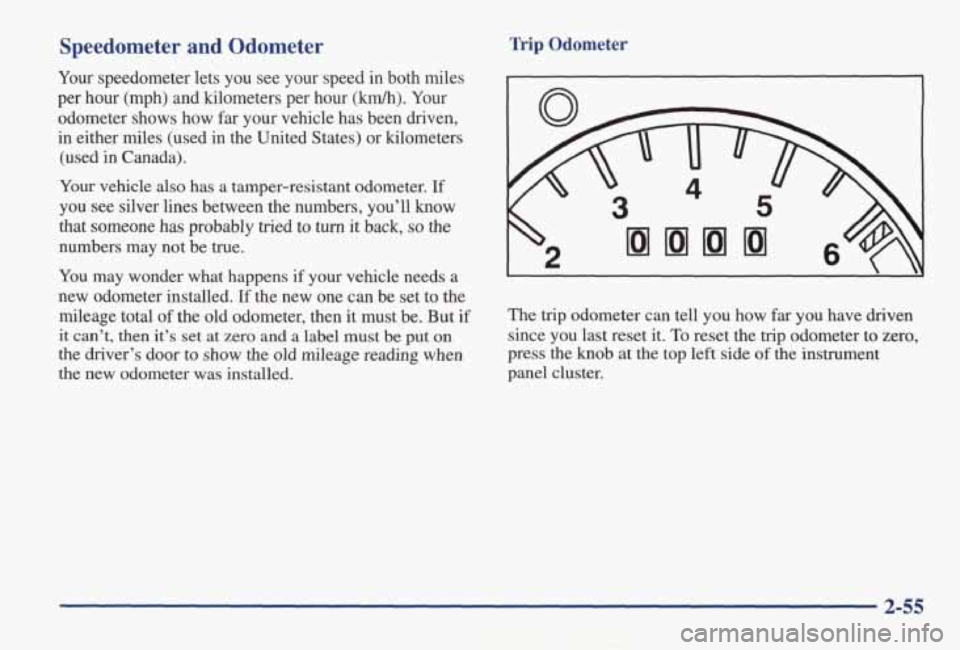
Speedometer and Odometer
Your speedometer lets you see your speed in both miles
per hour (mph) and kilometers per hour (km/h). Your
odometer shows how
far your vehicle has been driven,
in either
miles (used in the United States) or kilometers
(used in Canada).
Your vehicle also has
a tamper-resistant odometer. If
you see silver lines between the numbers, you’ll know
that someone has probably tried
to turn it back, so the
numbers may not be true.
You may wonder what happens if your vehicle needs a
new odometer installed.
If the new one can be set to the
mileage total of the old odometer, then it must be. But if
it can’t, then it’s set at zero and a label must be put on
the driver’s door to show the old mileage reading when
the new odometer was installed.
Trip Odometer
The trip odometer can tell you how far you have driven
since you last reset it.
To reset the trip odometer to zero,
press the
knob at the top left side of the instrument
panel cluster.
2-55
Page 117 of 370
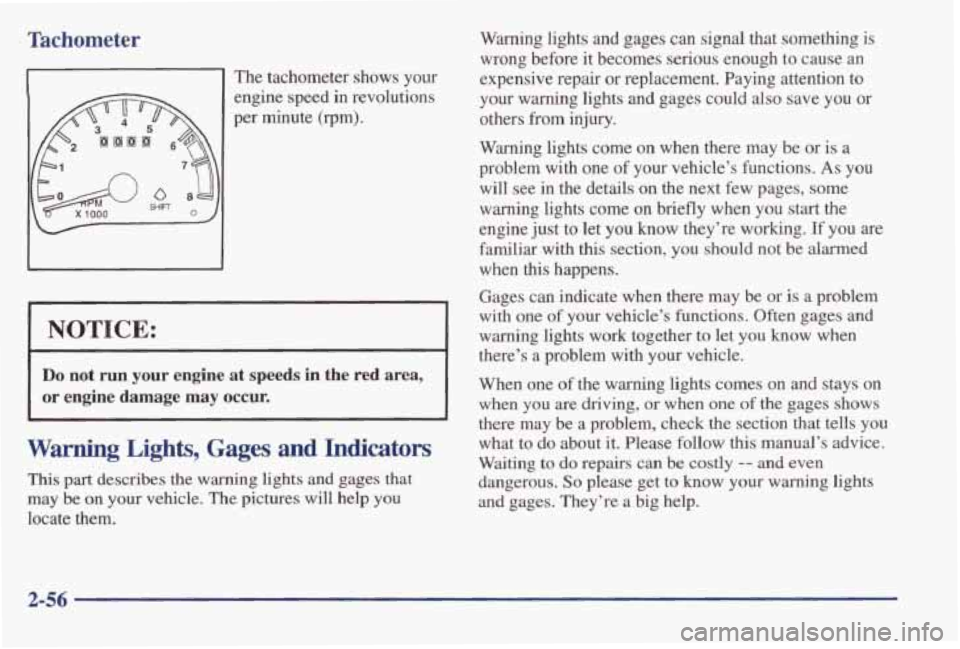
Tachometer
si The tachometer shows your
1 engine speed in revolutions
per minute (rpm).
NOTICE:
Do not run your engine at speeds in the red area,
or engine damage may occur. I
Warning Lights, Gages and Indicators
This part describes the warning lights and gages that
may be on your vehicle. The pictures will help you
locate them. Warning
lights
and gages can signal that something is
wrong before
it becomes serious enough to cause an
expensive repair or replacement. Paying attention to
your warning lights
and gages could also save you or
others from injury.
Warning lights come on when there may be or is a
problem
with one of your vehicle’s functions. As you
will see in the details on the next few pages, some
warning lights come
on briefly when you start the
engine just to let you
know they’re working. If you are
familiar with this section, you should not
be alarmed
when
this happens.
Gages can indicate when there may be or is
a problem
with one of your vehicle’s functions. Often gages and
warning lights work together to let you know when
there’s a problem with your vehicle.
When one
of the warning lights comes on and stays on
when you are driving,
or when one of the gages shows
there may
be a problem, check the section that tells you
what to do about
it. Please follow this manual’s advice.
Waiting
to do repairs can be costly -- and even
dangerous.
So please get to know your warning lights
and gages. They’re a big help.
2-56
Page 118 of 370
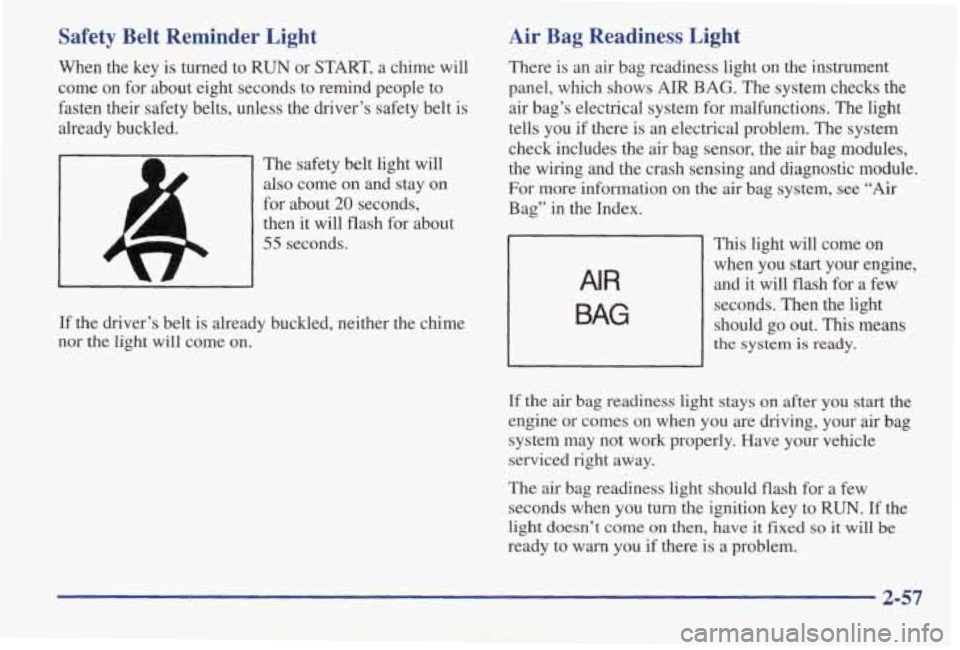
Safety Belt Reminder Light
When the key is turned to RUN or START, a chime will
come on for about eight seconds to remind people to
fasten their safety belts, unless the driver’s safety belt is
already buckled.
The safety belt light will
also come
on and stay on
for about 20 seconds,
then it will flash for about
55 seconds.
If the driver’s belt is already buckled, neither the chime
nor
the light will come on.
AIR
Air Bag Readiness Light
There is an air bag readiness light on the instrument
panel, which shows AIR
BAG. The system checks the
air bag’s electrical system for malfunctions. The light
tells you if there is an electrical problem. The system
check includes the air bag sensor, the air bag modules,
the wiring and the crash sensing and diagnostic module.
For more information on the
air bag system, see “Air
Bag” in the Index.
This light will come on
when you start your engine,
and it will flash for a few
seconds. Then the light
should go out. This means
the system is ready.
If the air bag readiness light stays on after you start the
engine or comes on when you are driving, your
air bag
system may not work properly. Have your vehicle
serviced right away.
The
air bag readiness light should flash for a few
seconds when you turn the ignition key to RUN.
If the
light doesn’t come on then, have it fixed so it will be
ready to warn you if there is a problem.
BAG
2-57
Page 119 of 370
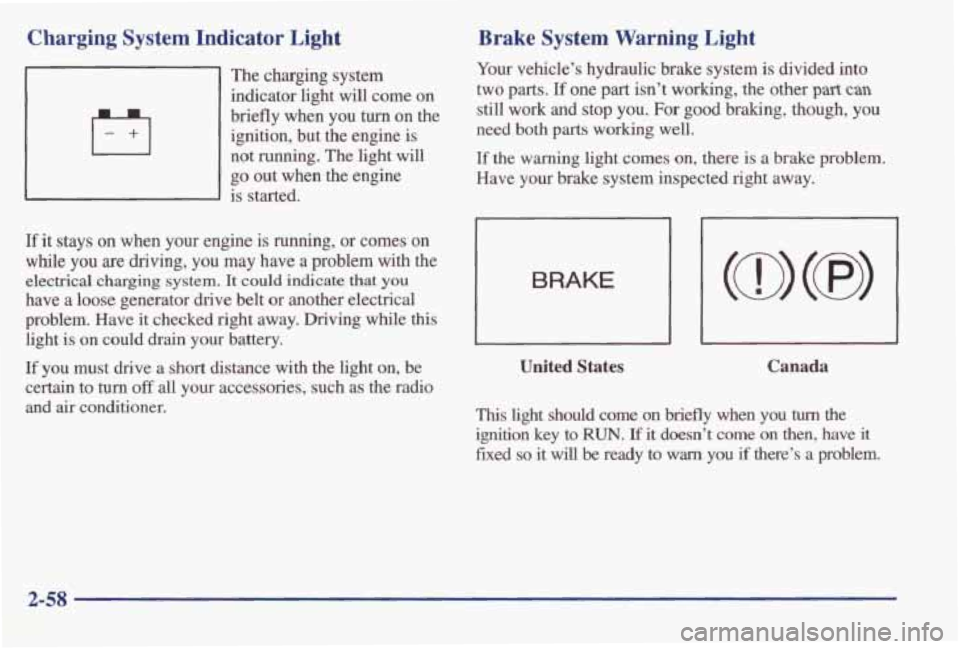
Charging System Indicator Light
~ The charging system
indicator light will come
on
briefly when you turn on the
ignition, but the engine is
not
running. The light will
go out when the engine
is started.
If it stays on when your engine is running, or comes on
while you are driving, you may have a problem with the
electrical charging
system. It could indicate that you
have a loose generator drive belt or another electrical
problem. Have it checked right away. Driving while
this
light is on could drain your battery.
If you must drive a short distance with the light on, be
certain to turn off all your accessories, such as the radio
and air conditioner.
Brake System Warning Light
Your vehicle’s hydraulic brake system is divided into
two parts. If one part isn’t working, the other part can
still work and stop you. For good braking, though, you
need
both parts working well.
If the warning light comes on, there is a brake problem.
Have your brake system inspected right away.
BRAKE
United States Canada
This light should come on briefly when you turn the
ignition key
to RUN. If it doesn’t come on then, have it
fixed so it will be ready to warn you if there’s a problem.
2-58
Page 120 of 370
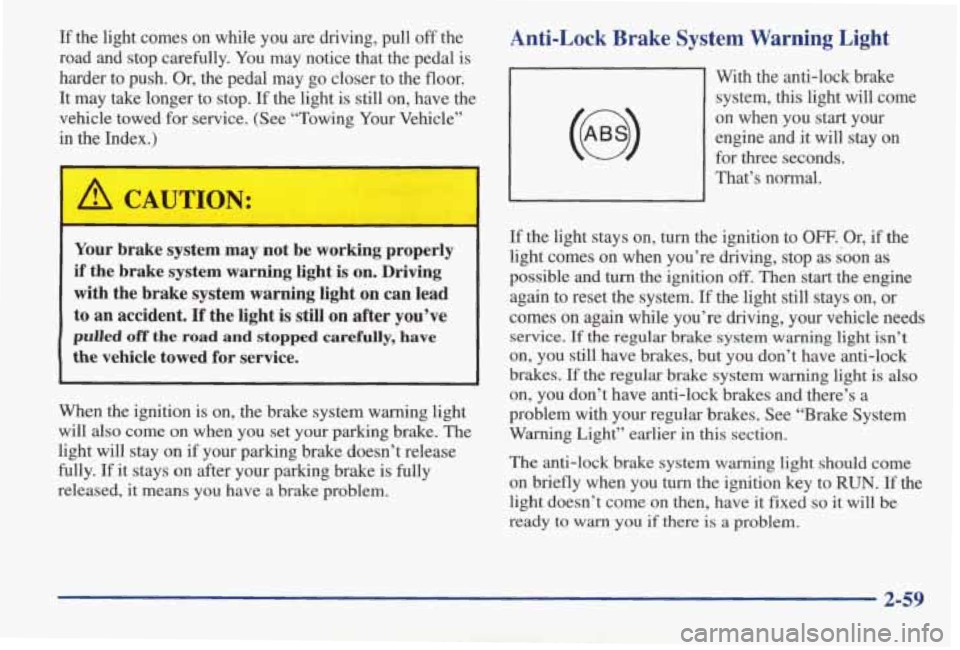
If the light comes on while you are driving, pull off the
road and stop carefully. You may notice that the pedal is
harder to push. Or, the pedal may
go closer to the floor.
It may take longer to stop. If the light
is still on, have the
vehicle towed for service. (See “Towing Your Vehicle”
in the Index.)
I A CAUTION:
Your brake system may not be working properly
if the brake system warning light is on. Driving
with the brake system warning light on can lead to an accident.
If the light is still on after you’ve
pulled off the road and stopped carefully, bqve
the vehicle towed for service.
When the ignition is on, the brake system warning light
will
also come on when you set your parking brake. The
light will stay on if your parking brake doesn’t release
fully.
If it stays on after your parking brake is fully
released, it means you have a brake problem.
Anti-Lock Brake System Warning Light
With the anti-lock brake
system,
this light will come
on when you
start your
engine
and it will stay on
for three seconds.
That’s normal.
If the light stays on, turn the ignition to OFF. Or, if the
light comes on when you’re driving, stop
as soon as
possible and turn the ignition off. Then start the engine
again to reset the system.
If the light still stays on, or
comes on
again while you’re driving, your vehicle needs
service. If the regular brake system warning light isn’t
on, you still have brakes, but you don’t have anti-lock
brakes.
If the regular brake system warning light is also
on, you don’t have anti-lock brakes and there’s a
problem with
your regular brakes. See “Brake System
Warning Light” earlier in this section.
The anti-lock brake system warning light should come
on briefly when you turn the ignition key to
RUN. If the
light doesn’t come on then, have it fixed
so it will be
ready
to warn you if there is a problem.
2-59